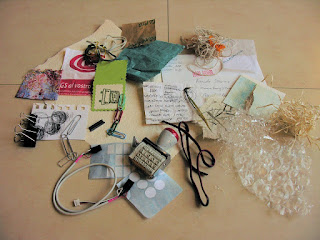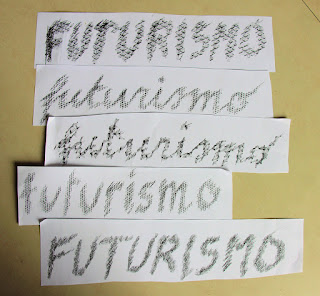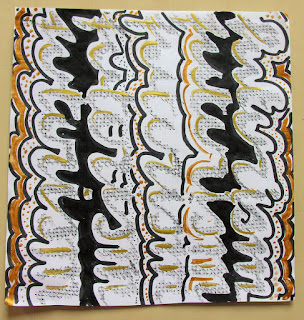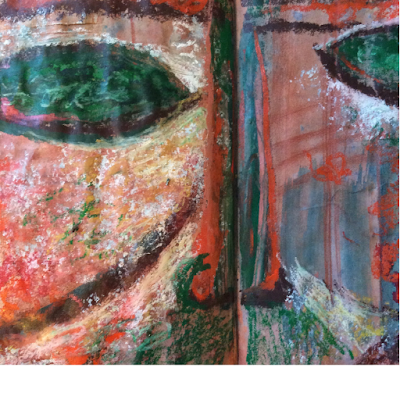Module 4- Chapters 1 and 2
CHAPTER ONE Media Research This is a photo of some items I have collected so far for future reference and work on Module Four. The collection is still growing and I'm using it mainly as a mental note of material that could be used. I have mostly included the following: - Papers that might be recycled - used printer paper, envelopes, different types of tissue papers/paper napkins, old grocery notes, used watercolour papers, oriental papers, used gift papers etc. - Different kinds of clips, strings, rubber bands, labels, packaging material like bubble wrap, chopped plastic and straw, an office multistamp - Electrical and computer cables as a reminder of the fact that media and communication at large are getting more and more immaterial (online newspapers, emails, internet etc.)  The two following images are collages of photocopied materials that might be further used. These are only copies since the originals are too precious to be directly recycled. They include handwritten notes I am particularly fond of (my grandma's writing on the yellow paper in the second photo), collectable old envelopes/stamps, details of famous dada paintings using letters/numbers.
The two following images are collages of photocopied materials that might be further used. These are only copies since the originals are too precious to be directly recycled. They include handwritten notes I am particularly fond of (my grandma's writing on the yellow paper in the second photo), collectable old envelopes/stamps, details of famous dada paintings using letters/numbers.
 Photo 2
Photo 2
 Photos 3 and 4 show basically a collection of typographic/graphic examples Photo 3
Photos 3 and 4 show basically a collection of typographic/graphic examples Photo 3
 Photo 4
Photo 4
 Photos 5 and 6 gather old lettering styles and some calligraphies Photo 5
Photos 5 and 6 gather old lettering styles and some calligraphies Photo 5
 Photo 6
Photo 6
 Photos 7 and 8 show some examples of different alphabets - old like Phoenician, Hebrew, Hyeroglyphic, Cuneiform and current like Arabic, Chinese, Japanese - and letters artistically combined Photo 7
Photos 7 and 8 show some examples of different alphabets - old like Phoenician, Hebrew, Hyeroglyphic, Cuneiform and current like Arabic, Chinese, Japanese - and letters artistically combined Photo 7
 Examples of "futurism" written dragging a black oil crayon on paper lying on different types of mesh.
Examples of "futurism" written dragging a black oil crayon on paper lying on different types of mesh.
 The two following images are collages of photocopied materials that might be further used. These are only copies since the originals are too precious to be directly recycled. They include handwritten notes I am particularly fond of (my grandma's writing on the yellow paper in the second photo), collectable old envelopes/stamps, details of famous dada paintings using letters/numbers.
The two following images are collages of photocopied materials that might be further used. These are only copies since the originals are too precious to be directly recycled. They include handwritten notes I am particularly fond of (my grandma's writing on the yellow paper in the second photo), collectable old envelopes/stamps, details of famous dada paintings using letters/numbers.
I have organized my material in several groups.
Images in photos 1 and 2 have mostly a sort of urban/modern feeling in common.
They include neon lights, light sculptures, advertisements, graffiti, maps etc.
Photo 1
 Photo 2
Photo 2  Photos 3 and 4 show basically a collection of typographic/graphic examples Photo 3
Photos 3 and 4 show basically a collection of typographic/graphic examples Photo 3  Photo 4
Photo 4  Photos 5 and 6 gather old lettering styles and some calligraphies Photo 5
Photos 5 and 6 gather old lettering styles and some calligraphies Photo 5  Photo 6
Photo 6  Photos 7 and 8 show some examples of different alphabets - old like Phoenician, Hebrew, Hyeroglyphic, Cuneiform and current like Arabic, Chinese, Japanese - and letters artistically combined Photo 7
Photos 7 and 8 show some examples of different alphabets - old like Phoenician, Hebrew, Hyeroglyphic, Cuneiform and current like Arabic, Chinese, Japanese - and letters artistically combined Photo 7
Writing a letter with the computer
For this exercise I used PaintShopPro and tried its different drawing tools
I chose FUTURISM - FUTUR as a word to put into repeat since 2009 celebrates the centenary from the birth of this artistic movement that is still inspiring and alive today in so many ways and under different forms.
From top to bottom:
Black ink dragged with an edge of card, drops of bleach on dry ink;
Futurism written with a Chinese brush, then rewritten with a wooden skewer and bleach;
Black ink strip, writing with a matchstick and bleach;
Word with the edge of a plastic card dragged on the flat side, then overwritten with the point of the card and bleach;
Blocks of ink with a card, then bleach dropped in a continuous line.
Serrated edge of plastic card;
Stamped using a "cuneiform" style;
Serrated edge of bristol card;
Word created by repeatedly stamping with an office stamp;
Stamping with a short edge of card.
 Examples of "futurism" written dragging a black oil crayon on paper lying on different types of mesh.
Examples of "futurism" written dragging a black oil crayon on paper lying on different types of mesh.
White oil crayon dragged on paper lying on a metal mesh, then black ink swished across;
Careful dragging of a card to form precise "futurist" style letters;
Stamping with the botton of a plastic earplug (the type they give you on airplanes);
Free-style lettering using a Chinese brush.
Black paper, letters formed in a "pointillist" style
 Black ink background, overwritten in bleach, finally drippings of watery acrylics
Black ink background, overwritten in bleach, finally drippings of watery acrylics

 Black ink background, overwritten in bleach, finally drippings of watery acrylics
Black ink background, overwritten in bleach, finally drippings of watery acrylics
Here follow some examples of patterns created on the computer when repeating the same word in different ways.
I especially like the rhythms created by enlarging small details.

Photo 1
Background in watered down black acrylic - PVA glue freely squeezed and let to dry - Overpainting of squeezed letters with metallic acrylic colours in different golden shades (I used Lumiere colours which are simply fantastic!)
Futurism written diagonally with a white oil crayon overpainted in watered down black acrylic - Strips of different writings cut in strips and applied, some folded - F repeated in geometric crossing patterns -Handwriting in ink
Futurism written several times with edge of card, with overlaps - Rewritten in bleach - Doodling in empty spaces with pen and ink
Photo 4
Sketch paper covered with acrylic gesso then combed with a plastic fork - Stencilling in of Japanese words with metallic Lumiere colours - Further writing crossways in pen and ink.
My intention was to reproduce a rough wall covered by different handwritings.
Another "piece of wall", this is more rugged and battered, I used gesso as before followed by black wax crayon and more Lumiere colours in the attempt to reproduce a graffito style wall in neon colours.
In making this sample I was thinking of Arabic handwriting even if the alphabet used is Latin.
Fluid writing with a Chinese brush - Further small writing in bleach within the words formed - Filling in with lettering doodling - Last layer of drops of different colours using a toothbrush to fuse words together.
Background obtained from dragging a black crayon on a gessoed/PVA glued surface, bleached letters cut up and pasted onto it.
In imitation of an urban graffito. Background is a rough gessoed surface overwritten with oil pastel and charcoal, then "sprayed" with some gold.
PVA dripping on a blackish background, then overpainted in metallic green after drying.
"Futurism" written several times over with a black oil pastel dragged on a meshed surface, empty spaces filled in with black and gold, then paper turned 90° upwards.
Word Futurism formed from separated letters pasted on a white background, then some letters echoed by radiating lines, empty spaces filled in by black points/golden stampings.


























I really enjoyed looking at the last set of photos of lettering patterns without the computer - some great effects with texture too. You've been so busy!
ReplyDeleteOh, WOW! So much work and so good!!! I'd better get my finger out and post what I've done or I'll look rather silly at Summer school!
ReplyDeleteBest wishes
This is an amazing post. What a lot of work and so inspiring
ReplyDeleteThank you Daniela for your kind comments! I can't believe how amazing your blog is, I can't wait to see what you do with all this research.
ReplyDeletelove Paula